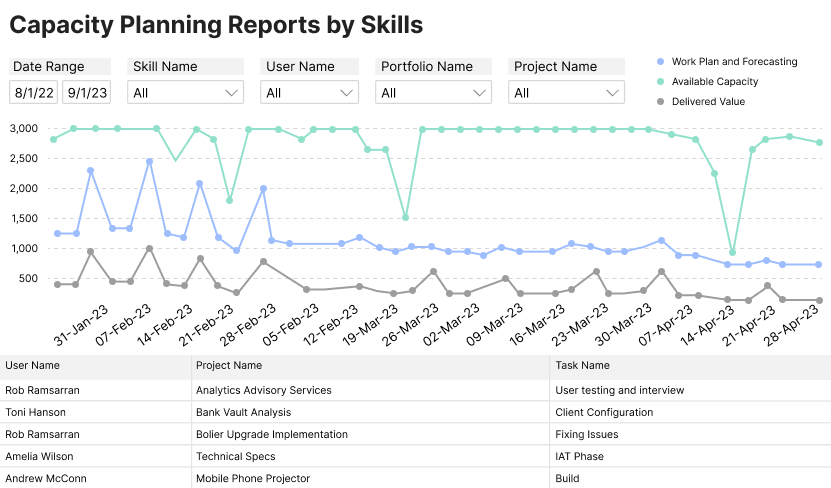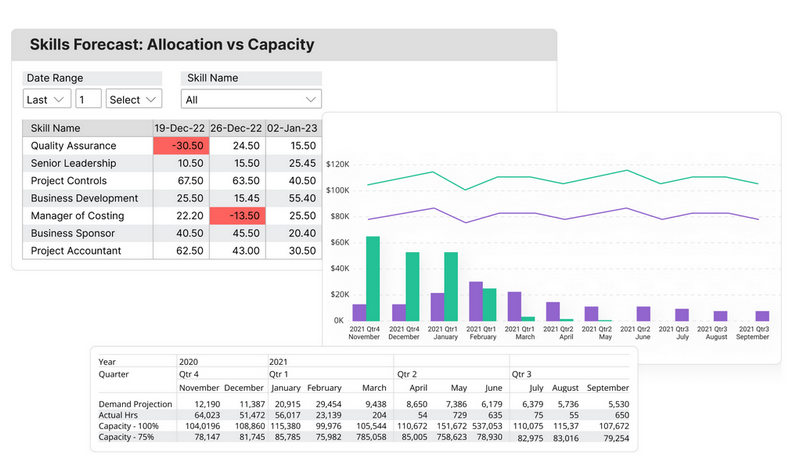Capacity planning is more than just a buzzword in project management–it’s a vital strategy that can make or break the success of your projects. Imagine trying to run a marathon without knowing if you have the stamina to finish; that‘s what managing a project without capacity planning feels like.
The goal of this article is to provide you with a comprehensive understanding of capacity planning. Whether you’re new to the concept or looking to refine your current strategies, we’ll guide you through the essentials of capacity planning, its key elements, and the steps involved. By the end, you‘ll have actionable insights and practical tips to implement effective capacity planning in your organization.
By the end of this article, you’ll understand how to harness the power of capacity planning to enhance efficiency, save costs, and boost overall project success. So, let’s dive in!
What is capacity planning?
Capacity planning in professional services ensures timely and efficient resource use, avoiding both overuse and underuse.
Capacity planning is a cornerstone of project management, especially for professional services teams. It involves determining the resources–be it personnel, technology, or facilities–needed to meet future client demands efficiently and effectively.
In simple terms, capacity planning is about aligning your available resources with the workload ahead. It‘s about understanding what you have now, predicting what you‘ll need in the future, and making a plan to ensure you meet those needs without overwhelming your team or wasting valuable assets.
Types of capacity planning
For professional services organizations, capacity planning can be divided into several types, each targeting different areas of resource management:
- Workforce Capacity Planning: This type focuses on making sure you have enough team members with the right skills to handle client projects. It includes strategic hiring, ongoing training, and efficient scheduling.
- Project Capacity Planning: Ensuring that your team can handle multiple projects simultaneously without compromising on quality or deadlines. This includes managing timelines, deliverables, and client expectations.
- Job Role Capacity Planning: This focuses on the ability to detect bottlenecks related to specific job roles or positions within the company. By identifying which roles are overburdened, you can reallocate tasks or provide additional support to ensure smooth project progress and avoid delays.

Why capacity planning is important
Effective capacity planning is crucial for professional services teams because:
- Optimized Resource Utilization: It ensures your team‘s skills and time are used efficiently, avoiding both idle time and burnout.
- Enhanced Project Delivery: Helps to implement client projects on time and within scope, thanks to the availability of all necessary resources.
- Cost Efficiency: Reduces costs associated with emergency hires, overtime pay, or underused resources.
- Informed Decision-Making: Provides data-driven insight into the availability or scarcity of resources that help in project planning, resource allocation, and scaling operations.
Capacity planning is not just about having enough resources but also the right resources at the right time. For professional services teams, it‘s a proactive approach that helps ensure you‘re always prepared to meet client demands and exceed their expectations.
Key components of capacity planning
To master capacity planning, professional services teams need to understand its core components. These elements work together to ensure that resources are allocated efficiently, projects are delivered on time, and clients are satisfied.
Forecasting. Forecasting is the first step in capacity planning. It involves predicting future project demands based on historical data, market trends, and upcoming client needs. Accurate forecasting helps in anticipating the resources required and planning accordingly. This means understanding the ebb and flow of project work and being prepared for peak periods.

Resource Allocation. Effective resource allocation ensures that the right resources are assigned to the right tasks at the right time. This involves matching team members’ skills and availability with project requirements. Proper resource allocation prevents bottlenecks, reduces idle time, and ensures that all team members are working on tasks that best utilize their expertise.
Balancing Supply and Demand. Balancing supply and demand is essential to avoid your team becoming overwhelmed or inactive. This involves constantly monitoring the project’s workload and adjusting resource allocation according to current needs. For professional services teams, this means flexibility and a willingness to reallocate resources as project priorities change.
Scalability. Scalability in capacity planning ensures that your team can handle increased workloads without compromising quality or deadlines. This involves having a flexible plan that can accommodate growth, whether it’s taking on more projects, expanding services, or increasing team size. Scalability is about being prepared for both current and future demands.
For effective capacity planning, the Project Manager must know the steps to ensure resources meet client expectations and deliver projects on time.
Capacity planning process: five steps
Effective capacity planning involves several basic steps:
1. Assess Current Capacity. Begin by evaluating your current resources. This includes understanding the availability and skill levels of your team members, the capacity of your technology and tools, and any other resources that contribute to project completion. This step helps you identify any existing gaps or areas of overcapacity.
2. Determine Future Needs. Next, forecast future resource requirements. This involves analyzing upcoming projects, client demands, and market trends. By understanding what lies ahead, you can predict the resources you’ll need and when you‘ll need them. This step is crucial for avoiding last-minute scrambles for resources or unexpected shortages.
3. Develop a Plan. With a clear picture of your current capacity and future needs, create a detailed capacity plan. This plan should outline how you will allocate resources over time to meet project demands. It should include strategies for hiring, training, and resource acquisition. A well-developed plan acts as a roadmap for ensuring that all projects have the resources they need.
4. Implement the Plan. Put your capacity plan into action. This involves scheduling resources, assigning tasks, and ensuring all team members know their responsibilities. Implementation requires coordination and communication to ensure that everyone is on the same page and that resources are utilized efficiently.
5. Monitor and Adjust. Capacity planning is not a one-time task but an ongoing process. Continuously monitor your resource utilization and project progress. Be prepared to make adjustments as needed, whether that means reallocating resources, bringing in additional help, or shifting project timelines. Regular monitoring ensures that your capacity planning remains effective and responsive to changes.
Benefits of capacity planning
Effective capacity planning offers a multitude of benefits for professional services teams. By carefully managing resources and anticipating future needs, organizations can improve efficiency, reduce costs, and enhance overall project outcomes. Here are some key benefits of capacity planning:
Enhanced Efficiency. Capacity planning ensures that resources are utilized optimally, preventing both underutilization and overburdening. When resources are allocated efficiently, projects run smoother, and teams can focus on delivering high-quality work. This leads to increased productivity and reduced project timelines.
Cost Savings. By avoiding the pitfalls of overstaffing or understaffing, capacity planning helps control labor costs. It eliminates the need for last-minute hires or costly overtime, ensuring that resources are available as needed without excess. This strategic approach to resource management translates into significant cost savings over time.
Improved Project Delivery. With capacity planning, professional services teams can better manage project schedules and meet deadlines. By aligning resources with project requirements, teams can avoid delays and ensure that deliverables are completed on time. This reliability enhances client satisfaction and builds trust.
Better Decision Making. Capacity planning provides data-driven insights that support informed decision-making. With a clear understanding of resource availability and project demands, managers can make strategic choices about which projects to take on and how to allocate resources effectively. This leads to better prioritization and more successful project outcomes.
Increased Flexibility. A well-structured capacity plan allows organizations to adapt quickly to changing project requirements or market conditions. By continuously monitoring and adjusting resource allocation, teams can respond swiftly to new opportunities or challenges, maintaining agility in a dynamic environment.
Enhanced Client Satisfaction. Meeting project deadlines and staying within budget are critical factors in client satisfaction. Capacity planning helps ensure that projects are delivered as promised, improving the overall client experience. Satisfied clients are more likely to return for future projects and recommend your services to others.
By focusing on these benefits, professional services teams can see the tangible value of implementing effective capacity planning strategies. This proactive approach not only improves operational efficiency but also drives long-term success and client loyalty.
Capacity planning challenges and solutions
Despite its many benefits, capacity planning comes with its own set of challenges. Here are some common challenges and strategies to address them:
Inaccurate Forecasting. Accurate forecasting is crucial for effective capacity planning, but it can be difficult to predict future project demands accurately. Inaccurate forecasts can lead to either resource shortages or excess capacity, both costly and disruptive.
Solution: One effective approach is integrating your Customer Relationship Management (CRM) system with your project management (PM) tool, such as Birdview PSA. When an opportunity in the CRM reaches a certain stage, a project can be automatically created in the PM system based on a predefined template with allocated resource placeholders. This allows you to understand the impact of upcoming projects on your organization more accurately. Additionally, use historical data, market trends, and advanced forecasting tools to improve accuracy.

Resource Constraints. Limited resources can pose significant challenges, especially when multiple projects require the same key resources. This can lead to bottlenecks, delays, and compromised project quality.
Solution: Prioritize projects based on strategic importance and allocate resources accordingly. Cross-train team members to increase flexibility and reduce dependency on specific individuals. Consider temporary staffing solutions during peak periods.
Changing Project Scope. Project scopes often change due to evolving client requirements, market conditions, or unforeseen issues. These changes can disrupt capacity plans and lead to resource imbalances.
Solution: Implement robust change management processes to handle scope changes effectively. Maintain flexibility in your capacity plan to accommodate adjustments, and communicate regularly with clients and stakeholders to manage expectations.
Balancing Multiple Projects. Managing capacity across multiple projects is inherently complex. Each project may have different timelines, resource needs, and priorities, making it challenging to balance them all effectively.
Solution: Use a centralized project management tool to gain a holistic view of all projects and resources. Prioritize projects and allocate resources based on overall business goals and project deadlines. Regularly review project statuses to ensure resources are being used optimally.
Lack of Real-Time Data. Without real-time data, capacity planning becomes a reactive process rather than a proactive one. This can lead to delayed responses to resource shortages or surpluses.
Solution: Invest in tools that provide real-time data on resource utilization, project progress, and capacity forecasts. Real-time insights enable quicker decision-making and more agile capacity planning.
What’s the difference between capacity planning and resource planning?
Capacity planning and resource planning are closely related concepts in project management, but they focus on different aspects of managing your team and project resources.
Capacity planning is the process of determining the overall production or service delivery capabilities of your organization over a certain period. It involves assessing whether your company has the right amount of people, skills, and equipment to meet project demands without overloading your team. In essence, capacity planning ensures that your organization can meet future project needs by evaluating the available bandwidth.
On the other hand, resource planning focuses on the allocation and scheduling of specific resources–such as people, tools, and materials–on a project-by-project basis. It‘s about assigning the right resources to the right tasks at the right time, ensuring that every aspect of the project is properly staffed and equipped. Resource planning is more tactical, dealing with day-to-day or week-to-week assignments, whereas capacity planning takes a broader, long-term view.
In short, capacity planning ensures that you have the overall resources to meet demand, while resource planning focuses on how those resources are distributed across individual projects. Both are essential for maintaining productivity and delivering successful projects.
Tools and techniques for effective capacity planning
To excel in capacity planning, professional services teams must utilize the right tools and techniques.
Techniques
Several techniques can be employed to improve capacity planning:
- Resource Leveling: Adjust the start and end dates of tasks to ensure resources are within the budget. This helps maintain a balanced workload and prevents burnout.
- Resource Smoothing: Ensure resources are utilized within their capacity limits without changing the project duration. This technique focuses on optimizing resource use without extending project timelines.
- Critical Path Method (CPM): Identify a project’s longest sequence of dependent tasks. By focusing on these critical tasks, you can ensure that resources are allocated to prevent any delays in the project timeline.
Software solutions
Many companies start their capacity planning journey with Excel or other spreadsheet software. While spreadsheets can be a powerful tool for organizing data and creating basic plans, they often fall short in several areas:
- Complexity: Managing large datasets and complex formulas can be cumbersome and error-prone.
- Lack of Real-Time Updates: Spreadsheets require manual updates, which can lead to outdated information and inaccuracies.
- Collaboration Challenges: Multiple team members working on the same spreadsheet can cause version control issues and data conflicts.
- Limited Automation: Spreadsheets lack advanced automation features, making it difficult to quickly adjust plans based on changing project needs.
Given these limitations, many professional services teams turn to specialized software to simplify capacity planning. Tools like Birdview PSA offer comprehensive features that streamline the entire process.
How to use Birdview PSA for capacity planning?
Using capacity planning with project management software like Birdview PSA involves leveraging its advanced features to forecast resource needs, track availability, and optimize resource allocation.
Birdview PSA enables project managers to create detailed plans, visualize resource use, and adjust schedules in real-time, preventing bottlenecks and ensuring efficient resource allocation.
Mastering elements like forecasting, resource allocation, and scalability helps organizations meet demands effectively. Birdview PSA’s real-time insights, automation, and collaboration features streamline processes and boost efficiency.
Prioritize capacity planning today to see the positive impact on your organization‘s success. With the right approach and tools like Birdview PSA, you can consistently meet and exceed your project goals.
Enhance workflow by leveraging Birdview PSA‘s
resource capacity planning tools
Related resource capacity planning articles
If you want to explore resource capacity planning further, Birdview PSA is here to help. Along with our project management software, you‘ll get access to free templates, blogs, Guides, and eBooks. Here‘s a sample of that content as related to resource capacity planning.
- Resource capacity planning for project management
- Capacity planning and resource planning: What is different?
- Resource planning and capacity planning reporting and dashboards
- Resource management metrics and KPIs in project management



